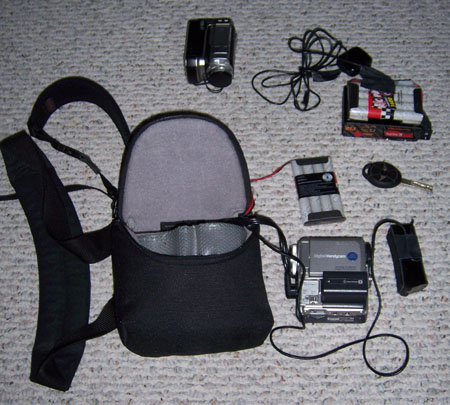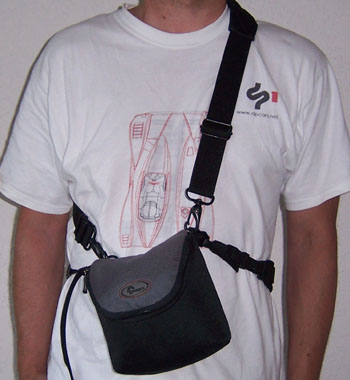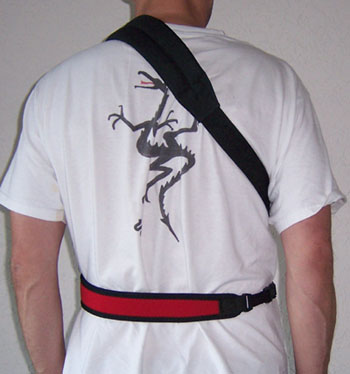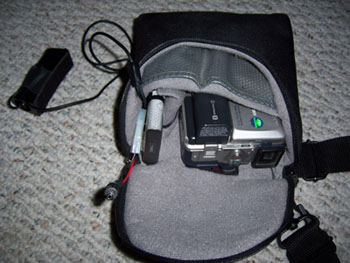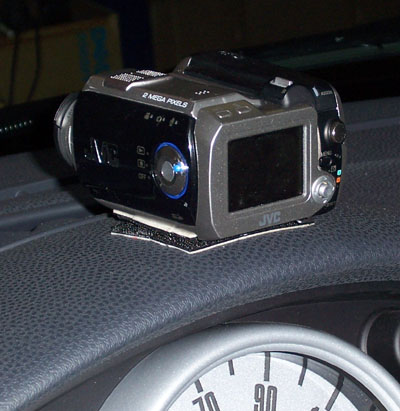|
06/24/06 People keep asking me about the details on various electronics I use to capture video and data for the site, so for quite some time I've been meaning to do a writeup on that. Today I got yet another request for information and it finally prodded me to sit down and do it. So here goes. Each of the components is individually described below.
Helmet camera: For a lot of the videos I use a helmet-mounted camera from ChaseCam. I used to have a camera from another vendor but when it died I got the higher-resolution one that I use now. I still attach it with the previous mount, just because I like the chunky billet-machined feel of it. The camera requires a camcorder with a composite input and my trusty Sony DCR-PC5 Mini DV serves in that role. It's compact, reliable and fairly easy to use. Power for the helmet cam is provided by a Radio Shack 9.6V RC car battery. Works great and is cheap and available. The camera itself can be mounted in many ways. I got a few different mounts from ChaseCam but haven't gotten around to trying them yet. This is mostly because I find that helmet mount is the most interesting and natural way to capture video as it gives the driver's view and the camera pans with head movement when I look through turns. The entire package is housed in a camera bag that I got at a local camera store. The microphone is also in the bag. It all looks like this in use:
The camera is attached to the helmet with 3M Dualock industrial 'velcro'. I use the stuff for a lot of purposes, it can be purchased online from McMaster Carr (item number 96055K43, about $2/foot). While on the subject of attachment means, another favorite item is 'Gaffer Tape'. It's available online from a variety of vendors and comes in many grades and colors. I usually get it from FindTape. What's great about it is that it leaves none of the nasty residue that regular duct tape does. Just peels off, nice and clean. Well worth the extra cost over hardware-store stuff. The resulting setup is nice in that it's completely self-contained and I can wear it in any vehicle - cars, motorcycles and even aerobatic airplanes. Yes, it's been successfully tested to +6.5/-1.5g vertical in an airplane, +/-2g lateral in a DSR, and 175 mph on a motorcycle :) There is no need to worry about finding a place to mount the camera and the camcorder, or routing wires. Once the velcro is on the helmet you just always stick the camera in the same place and you know the field of view will be consistent. Another benefit is that the camcorder is totally isolated from any vibration. All of this definitely makes helmetcam the rig of choice when I drive or ride in other people's vehicles or those without easy mounting means, such as the kart. Just get in and go, no hassle. The shoulder strap carries the bag and the elastic waist strap keeps it from flopping around. There are some drawbacks to using it however. First, while being reasonably compact, it can still be a bit awkward and get in the way. On motorcycles I shift the bag to my back but if I were to crash with it there (which thankfully I haven't, yet) I think there could be some potential damage to both the camera and myself. After my recent 748 crash I was reminded that it can in fact happen so I don't think I'll be using this on motorcycles anymore. The other issue is that to start recording requires a bit of messing with it - plugging in the battery connector to start power to the camera, turning on the camcorder, going through menus to get to the VCR function and then starting it. Because of this it needs to be done before going out to pre-grid and without gloves on. Which isn't a problem if the session is started promptly but sometimes we end up sitting there for 5-10 minutes and all the while it's burning through batteries and tape. The camcorder battery and tape both last about an hour, good for three 20-minute sessions. Any significant delays can really cut into that. JVC Everio MC-200. There is a trend for new cameras to go solid state and record directly in MPEG2 and this is one of the first full-resolution (720x480) 30fps cameras of this type. I got it hoping it would be small enough to mount directly to the helmet but unfortunately it isn't. Instead, I mount it with the Dualock stuff to the dash. I'll also experiment with some mounts I got from ChaseCam to try and mount it on motorcycles instead of using the helmet cam. First setup I tried on the PS was not very satisfactory (too much shaking) but there are a few others I can use. Watch the bike pages for updates on that.
The camera comes standard with a 4G MicroDrive but I've found that it's sensitive to vibration (power hungry, too) so I replaced it with a 4G FLASH card. 45X speed is sufficient to record at full resolution with no problems though it does take a long time to transfer video from card to computer afterwards. Full 4G can take about an hour, or roughly the same as it takes to record it. A faster card is not needed to record but it would decrease upload times. I'm fine with this one. Benefits of the JVC include the compact size, a 10X optical zoom and the ability to take 2 Megapixel stills in a pinch which come out OK. Video quality is excellent (as long as there is enough light, it's low-light performance is pretty poor compared to the Sony). MPEG2 files are easily edited with just about any video program and play directly on any media player, including the DVD player I have hooked up to the TV. But, as anything, it's not without drawbacks. One issue is that there is no composite input so it can't be used with a helmet cam. The biggest annoyance however is an overactive autofocus which occasionally tends to activate with no provocation. I haven't found a way to turn it off and it has ruined more than one in-car video by choosing to focus on bugs on windshield instead of the road ahead. DL-1 datalogger from Race Technology. If you've read any of my recent car and bike entries you've seen the data and how valuable it is as an educational tool. As with many things I ended up making a few tweaks to make it better suit my purposes.
One goal was to make the unit easy to move between vehicles, some of which don't have available power outlets. So the first order of business was to get another RC car battery and to attach it to the logger (you guessed it, using the velcro stuff). I also epoxied a power switch to the side of the case so I don't have to fumble with plugging and unplugging connectors to turn it on and off. And lastly I shortened the antenna wire to a much more reasonable 5 feet (from something like 20?). This actually was 'enabled' by my crash on the 748 which ripped the wire out of the connector. Since I had to resolder it I figured I'd shorten it at the same time and it worked great. The DL-1 survived the crash despite being thrown a dozen feet from the bike and coated with mud, dutifully recording the event taking place at 55 mph. It was amusing to see that the slide scrubbed off speed pretty gradually - the bike slid for some 50-75 feet. The result of my tweaks is a compact, completely self-contained unit that is easy to move around and effortless to operate. The preferred method of attaching the datalogger is, of course, velcro. Secured with gaffer tape as a backup, in most cases. It works. |
